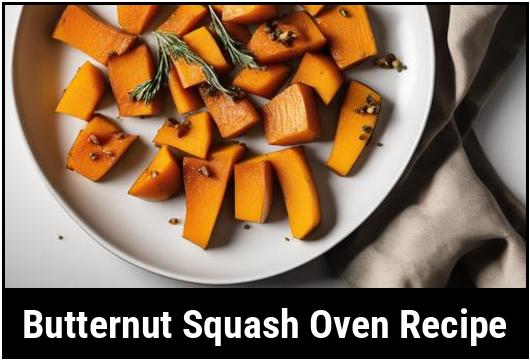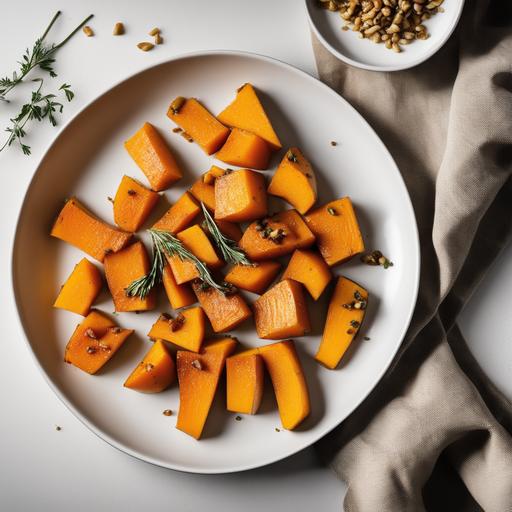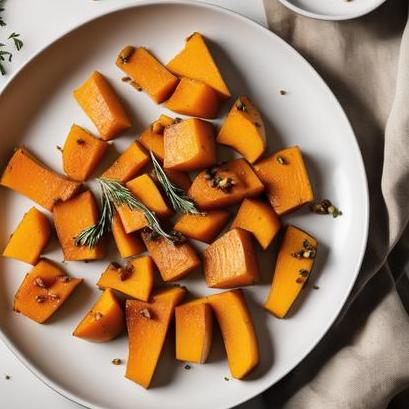
The Flavorsome Delight: Butternut Squash Oven Recipe
Exploring the Culinary Wonders of Butternut Squash
Are you ready to embark on a gastronomic adventure that will tantalize your taste buds and warm your soul? Look no further than the delightful butternut squash oven recipe. Bursting with rich flavors and packed with nutritional benefits, this seasonal delicacy will leave you craving for more. In this comprehensive guide, we will delve into the intricacies of this versatile vegetable, covering everything from selection to preparation, tips, variations, recipe, and even potential pitfalls. So, roll up your sleeves and let’s get started on this culinary journey!
Understanding the Food Science Behind Butternut Squash
Before diving into the culinary details, it’s essential to understand the food science behind butternut squash. This vibrant orange vegetable belongs to the Cucurbitaceae family, which also includes pumpkin, zucchini, and cucumbers. Butternut squash boasts a delectable nutty flavor and a creamy, slightly sweet flesh. Rich in vitamins A and C, potassium, and fiber, it not only tantalizes the taste buds but also provides a host of health benefits.
When exposed to heat during the cooking process, the natural sugars within the squash caramelize, enhancing its inherent sweetness. The oven, with its even heat distribution, allows for slow and controlled cooking, resulting in tender and perfectly roasted butternut squash. So, let’s proceed with the various aspects of selecting, cleaning, and preparing this delightful vegetable for oven-roasting.
Selecting the Perfect Butternut Squash

When selecting butternut squash, it is vital to choose ones that are firm, heavy, and free from blemishes or mold. The skin should have a matte appearance with a vibrant orange hue. Avoid squashes with any soft spots, as they may indicate spoilage. The size of the squash doesn’t necessarily affect its flavor or quality, so feel free to opt for smaller or larger ones based on your needs.
Cleaning and Preparing the Squash
To ensure a delectable outcome, it’s crucial to thoroughly clean and prepare the squash before roasting. Start by rinsing the outside of the squash under cold water to remove any dirt or debris. Next, wipe it dry using a kitchen towel.
To make the squash easier to handle and cook more evenly, some home cooks prefer to peel it before roasting. In this case, a sharp vegetable peeler or a paring knife can be used to remove the tough outer skin. However, leaving the skin intact can add an appealing texture and robust flavor to your roasted butternut squash.
After peeling, slice off the top and bottom of the squash, and then halve it lengthwise. Use a spoon to scoop out the seeds and fibrous strands from the center, similar to how one would clean a pumpkin. Save the seeds if you want to try toasting them later for a crunchy snack.
Tips and Variations for Flavorful Roasting
To elevate your butternut squash oven recipe, we have compiled a few tips and variations that will surely tickle your taste buds and provide versatility to your culinary repertoire:
1. Seasoning and Flavors: Butternut squash pairs exceptionally well with a range of flavors, both savory and sweet. Consider enhancing its natural taste by using spices like cinnamon, nutmeg, or smoked paprika. For a savory twist, herbs such as rosemary or thyme work wonders.
2. Sweet and Savory Combinations: If you’re feeling adventurous, experiment with combining the sweetness of butternut squash with contrasting savory ingredients. Dried cranberries, goat cheese, walnuts, or even bacon can add fascinating layers of flavors to your roasted masterpiece.
3. Cubes versus Halves: While the classic method involves roasting large halves of butternut squash, cutting it into smaller cubes can speed up the cooking process and offer a versatile option for various recipes. Consider adjusting the cooking time accordingly if you decide to go the cubed route.
4. Glazed or Brushed: To add shine and depth to your roasted butternut squash, try glazing it with maple syrup or honey before baking. This will create a luscious, caramelized coating that amplifies both taste and presentation.
5. Complementary Vegetables: Butternut squash plays well with various other vegetables, complementing their flavors and textures. Consider roasting it alongside carrots, sweet potatoes, or Brussels sprouts for a vibrant medley of colors and tastes.
Determining the Perfect Doneness

Achieving the perfect doneness is crucial when it comes to roasted butternut squash. Overcooking it can lead to mushy or burnt results, while undercooking may result in an unpleasant hard texture. The following factors are essential to consider:
1. Cooking Time: The cooking time can vary depending on various factors, such as the size and thickness of the squash, temperature, and the desired texture. In general, roasted butternut squash halves may take around 45-60 minutes at 375°F (190°C) until fork-tender. Cubes, being smaller, will cook more quickly within 25-35 minutes.
2. Texture: The ideal doneness is achieved when the butternut squash is tender, easy to cut, and can be mashed effortlessly with a fork. Aim for a soft, velvety flesh that still retains its shape.
3. Baking Dish: Choosing an appropriate baking dish plays a role in determining the doneness of your roasted squash. A glass or ceramic dish can ensure even heat distribution, providing a more consistent outcome.
An Irresistible Butternut Squash Oven Recipe
Now that we have explored the various aspects of selecting, cleaning, preparing, and achieving the perfect texture, it’s time to unleash the flavors of this delightful vegetable with a mouthwatering butternut squash oven recipe:
Ingredients:
-
1 butternut squash (2-3 pounds)
-
2 tablespoons olive oil
-
1 teaspoon ground cinnamon
-
1/2 teaspoon ground nutmeg
-
Salt and pepper to taste
-
Optional: 2 tablespoons maple syrup or honey for glazing
Instructions:
-
Preheat your oven to 375°F (190°C) and position the rack in the center.
-
Prepare the butternut squash by peeling (optional) and removing the seeds as detailed earlier.
-
Slice the squash into even halves, lengthwise, or into equally sized cubes depending on your preference.
-
If glazing, drizzle maple syrup or honey over the sliced sides of the squash and spread evenly using a pastry brush.
-
In a small bowl, mix together the olive oil, cinnamon, nutmeg, salt, and pepper.
-
Brush the seasoned mixture generously over the exposed flesh of the squash.
-
Place the squash, cut side up, onto a baking dish.
-
Roast the halves for approximately 45-60 minutes or until fork-tender.
-
If roasting cubes, check for doneness after 25-35 minutes until the desired texture is achieved.
-
Once fully cooked, remove from the oven and allow the squash to cool for a few minutes before serving.
Prevention and Avoidance of Undercooking or Overcooking
While roasted butternut squash is a culinary delight, its unique characteristics can also lead to challenges in achieving the perfect results. Here are some useful pointers to prevent undercooking or overcooking:
1. Consistent Cube Sizes: If you opt for cubes instead of halves, ensure all the pieces are of similar size to ensure even cooking.
2. Temperature Control: Maintain an accurate oven temperature throughout the cooking process. Deviations can cause uneven cooking and result in overcooked or undercooked sections.
3. Regular Checks: Keep a close eye on your squash as it roasts, especially as you approach the expected cooking time. Insert a fork into the thickest part of the squash to determine its tenderness. The fork should come out easily without any resistance.
4. Adjusting Cooking Time: If you find your butternut squash is undercooked, return it to the oven in intervals of 5-10 minutes until it reaches the desired tenderness. Similarly, if you notice your squash is overcooking, remove it from the oven earlier than anticipated to prevent further softening.
Conclusion: Unleash the Full Potential of Butternut Squash
In summary, the butternut squash oven recipe provides a delightful marriage of flavors, textures, and healthy benefits. Armed with the understanding of food science, culinary techniques, and various tips, you can confidently embark on your own exploration of this versatile vegetable.
Remember to select a firm and blemish-free squash, clean and prepare it lovingly, and experiment with different flavors and accompaniments to accentuate its natural taste. Pay close attention to achieving the perfect doneness and adjust as needed to prevent undercooking or overcooking.
With this comprehensive guide, you are well-equipped to dive into the world of butternut squash oven recipes. So fire up your oven, embrace your inner culinary artist, and indulge in the flavorful wonders of this delightful seasonal vegetable. Here’s to happy cooking and enjoying the rich gastronomical experiences that await you!
Sources
FAQS On Butternut Squash Oven Recipe
What Is The Best Way To Bake A Butternut Squash In The Oven?
To bake a butternut squash in the oven, first preheat the oven to 400 degrees Fahrenheit. Then, slice the squash in half lengthwise and scoop out the seeds. Place the halves in a baking dish with the cut sides facing up and brush with olive oil. Bake for 45-60 minutes, until the squash is easily pierced with a fork.
Can I Eat The Skin Of A Baked Butternut Squash?
Yes, the skin of a baked butternut squash is edible and becomes tender when cooked. However, some people may choose to peel off the skin before consuming for a smoother texture.
How Can I Add Flavor To My Butternut Squash Oven Recipe?
There are various ways to add flavor to a butternut squash oven recipe. Some options include seasoning the squash with herbs and spices, such as cinnamon, nutmeg, or rosemary, before baking. You can also brush the squash with a marinade or glaze, such as a maple syrup and balsamic vinegar mixture, before baking.
Do I Need To Cover The Butternut Squash While Baking In The Oven?
It is not necessary to cover the butternut squash while baking in the oven. However, if you prefer a softer texture, you can cover the baking dish with foil for the first half of the baking time and then remove it for the remaining time.
How Long Does It Take To Bake Butternut Squash Cubes In The Oven?
It takes approximately 25-35 minutes to bake butternut squash cubes in the oven at 400 degrees Fahrenheit. To ensure even cooking, make sure the cubes are spread out in a single layer on a baking sheet and flip them halfway through the cooking time.



